Microservice Architecture : Software Structure and Software Components
VerifiedAdded on 2022/08/13
|12
|2824
|24
AI Summary
Contribute Materials
Your contribution can guide someone’s learning journey. Share your
documents today.
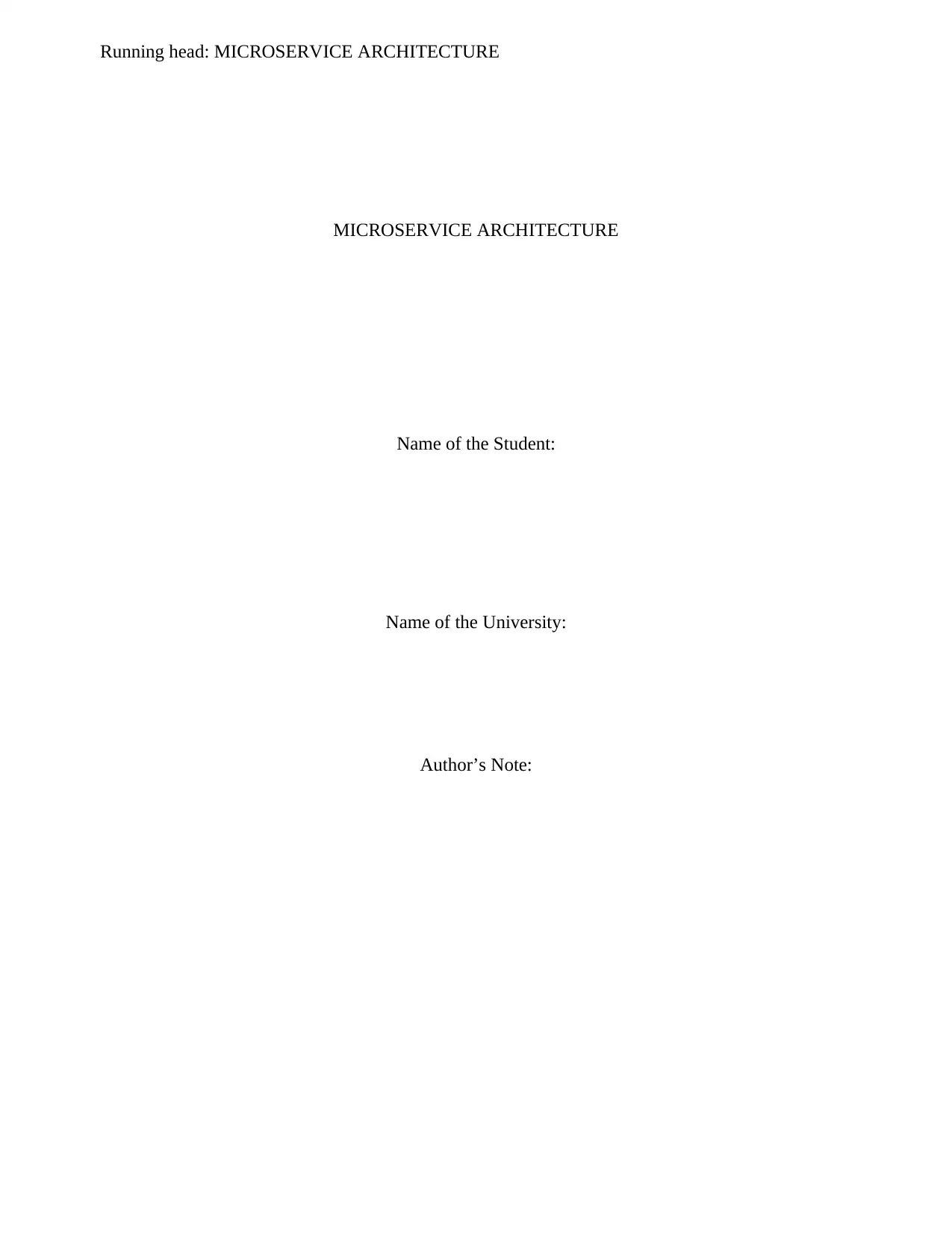
Running head: MICROSERVICE ARCHITECTURE
MICROSERVICE ARCHITECTURE
Name of the Student:
Name of the University:
Author’s Note:
MICROSERVICE ARCHITECTURE
Name of the Student:
Name of the University:
Author’s Note:
Secure Best Marks with AI Grader
Need help grading? Try our AI Grader for instant feedback on your assignments.
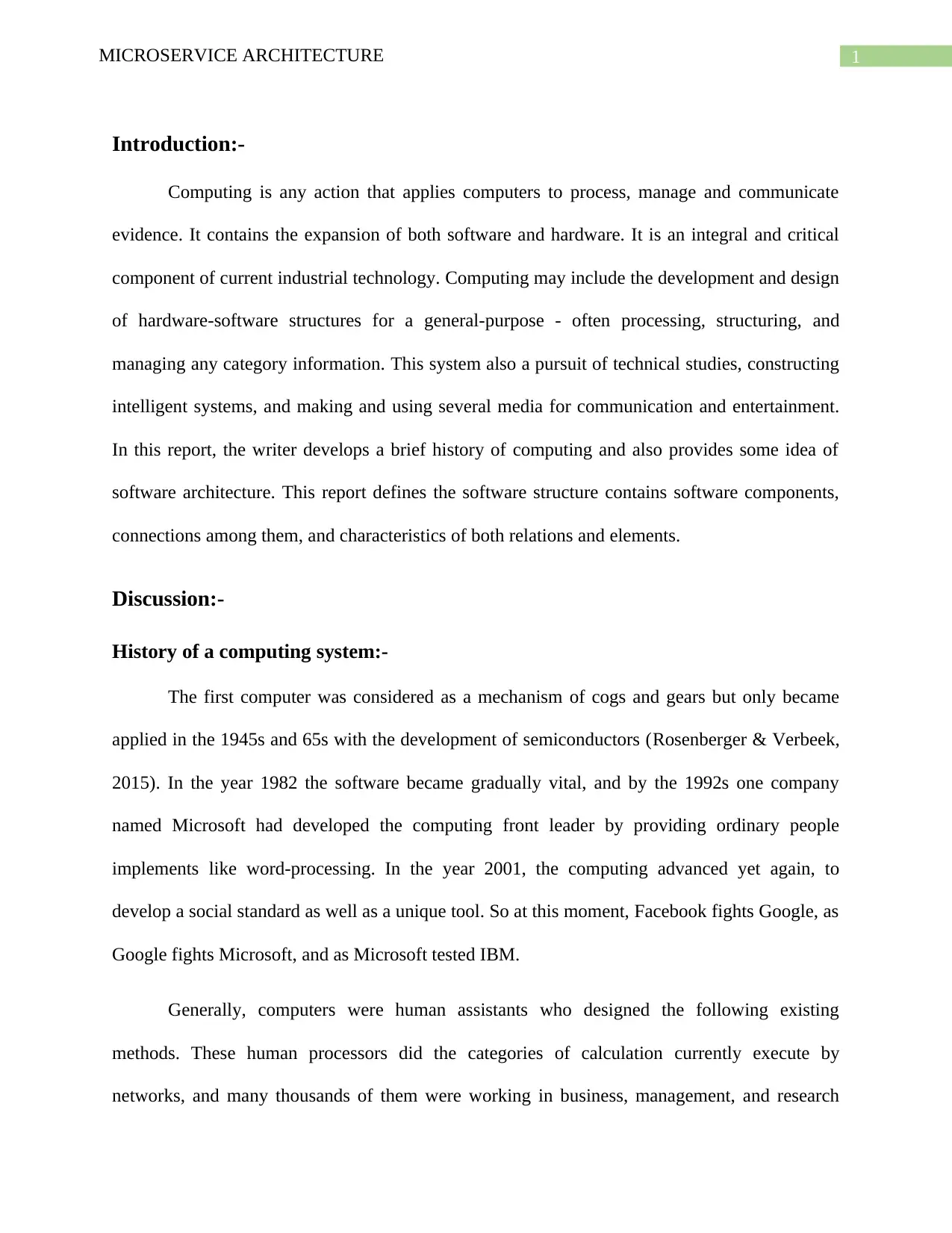
1MICROSERVICE ARCHITECTURE
Introduction:-
Computing is any action that applies computers to process, manage and communicate
evidence. It contains the expansion of both software and hardware. It is an integral and critical
component of current industrial technology. Computing may include the development and design
of hardware-software structures for a general-purpose - often processing, structuring, and
managing any category information. This system also a pursuit of technical studies, constructing
intelligent systems, and making and using several media for communication and entertainment.
In this report, the writer develops a brief history of computing and also provides some idea of
software architecture. This report defines the software structure contains software components,
connections among them, and characteristics of both relations and elements.
Discussion:-
History of a computing system:-
The first computer was considered as a mechanism of cogs and gears but only became
applied in the 1945s and 65s with the development of semiconductors (Rosenberger & Verbeek,
2015). In the year 1982 the software became gradually vital, and by the 1992s one company
named Microsoft had developed the computing front leader by providing ordinary people
implements like word-processing. In the year 2001, the computing advanced yet again, to
develop a social standard as well as a unique tool. So at this moment, Facebook fights Google, as
Google fights Microsoft, and as Microsoft tested IBM.
Generally, computers were human assistants who designed the following existing
methods. These human processors did the categories of calculation currently execute by
networks, and many thousands of them were working in business, management, and research
Introduction:-
Computing is any action that applies computers to process, manage and communicate
evidence. It contains the expansion of both software and hardware. It is an integral and critical
component of current industrial technology. Computing may include the development and design
of hardware-software structures for a general-purpose - often processing, structuring, and
managing any category information. This system also a pursuit of technical studies, constructing
intelligent systems, and making and using several media for communication and entertainment.
In this report, the writer develops a brief history of computing and also provides some idea of
software architecture. This report defines the software structure contains software components,
connections among them, and characteristics of both relations and elements.
Discussion:-
History of a computing system:-
The first computer was considered as a mechanism of cogs and gears but only became
applied in the 1945s and 65s with the development of semiconductors (Rosenberger & Verbeek,
2015). In the year 1982 the software became gradually vital, and by the 1992s one company
named Microsoft had developed the computing front leader by providing ordinary people
implements like word-processing. In the year 2001, the computing advanced yet again, to
develop a social standard as well as a unique tool. So at this moment, Facebook fights Google, as
Google fights Microsoft, and as Microsoft tested IBM.
Generally, computers were human assistants who designed the following existing
methods. These human processors did the categories of calculation currently execute by
networks, and many thousands of them were working in business, management, and research
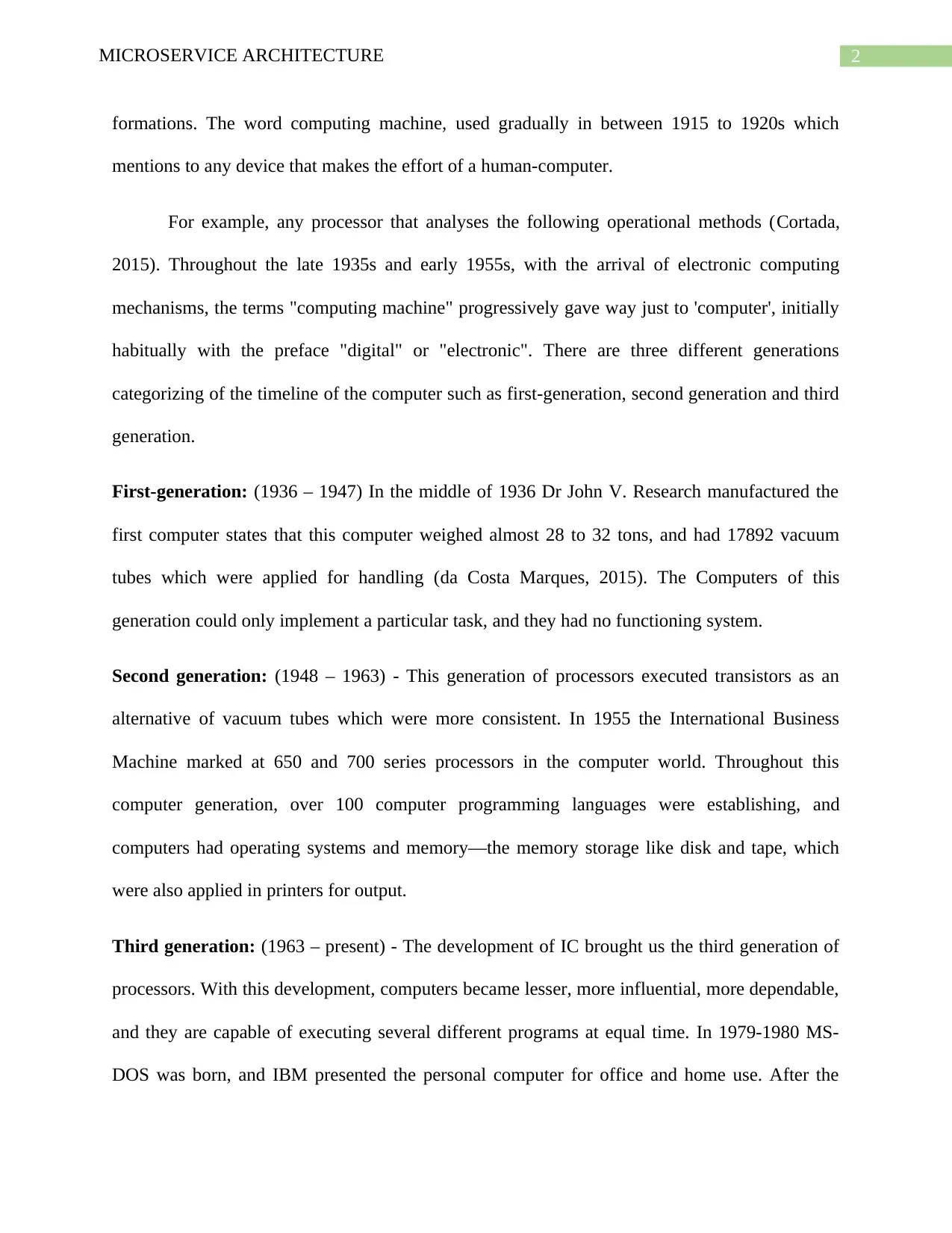
2MICROSERVICE ARCHITECTURE
formations. The word computing machine, used gradually in between 1915 to 1920s which
mentions to any device that makes the effort of a human-computer.
For example, any processor that analyses the following operational methods (Cortada,
2015). Throughout the late 1935s and early 1955s, with the arrival of electronic computing
mechanisms, the terms "computing machine" progressively gave way just to 'computer', initially
habitually with the preface "digital" or "electronic". There are three different generations
categorizing of the timeline of the computer such as first-generation, second generation and third
generation.
First-generation: (1936 – 1947) In the middle of 1936 Dr John V. Research manufactured the
first computer states that this computer weighed almost 28 to 32 tons, and had 17892 vacuum
tubes which were applied for handling (da Costa Marques, 2015). The Computers of this
generation could only implement a particular task, and they had no functioning system.
Second generation: (1948 – 1963) - This generation of processors executed transistors as an
alternative of vacuum tubes which were more consistent. In 1955 the International Business
Machine marked at 650 and 700 series processors in the computer world. Throughout this
computer generation, over 100 computer programming languages were establishing, and
computers had operating systems and memory—the memory storage like disk and tape, which
were also applied in printers for output.
Third generation: (1963 – present) - The development of IC brought us the third generation of
processors. With this development, computers became lesser, more influential, more dependable,
and they are capable of executing several different programs at equal time. In 1979-1980 MS-
DOS was born, and IBM presented the personal computer for office and home use. After the
formations. The word computing machine, used gradually in between 1915 to 1920s which
mentions to any device that makes the effort of a human-computer.
For example, any processor that analyses the following operational methods (Cortada,
2015). Throughout the late 1935s and early 1955s, with the arrival of electronic computing
mechanisms, the terms "computing machine" progressively gave way just to 'computer', initially
habitually with the preface "digital" or "electronic". There are three different generations
categorizing of the timeline of the computer such as first-generation, second generation and third
generation.
First-generation: (1936 – 1947) In the middle of 1936 Dr John V. Research manufactured the
first computer states that this computer weighed almost 28 to 32 tons, and had 17892 vacuum
tubes which were applied for handling (da Costa Marques, 2015). The Computers of this
generation could only implement a particular task, and they had no functioning system.
Second generation: (1948 – 1963) - This generation of processors executed transistors as an
alternative of vacuum tubes which were more consistent. In 1955 the International Business
Machine marked at 650 and 700 series processors in the computer world. Throughout this
computer generation, over 100 computer programming languages were establishing, and
computers had operating systems and memory—the memory storage like disk and tape, which
were also applied in printers for output.
Third generation: (1963 – present) - The development of IC brought us the third generation of
processors. With this development, computers became lesser, more influential, more dependable,
and they are capable of executing several different programs at equal time. In 1979-1980 MS-
DOS was born, and IBM presented the personal computer for office and home use. After the
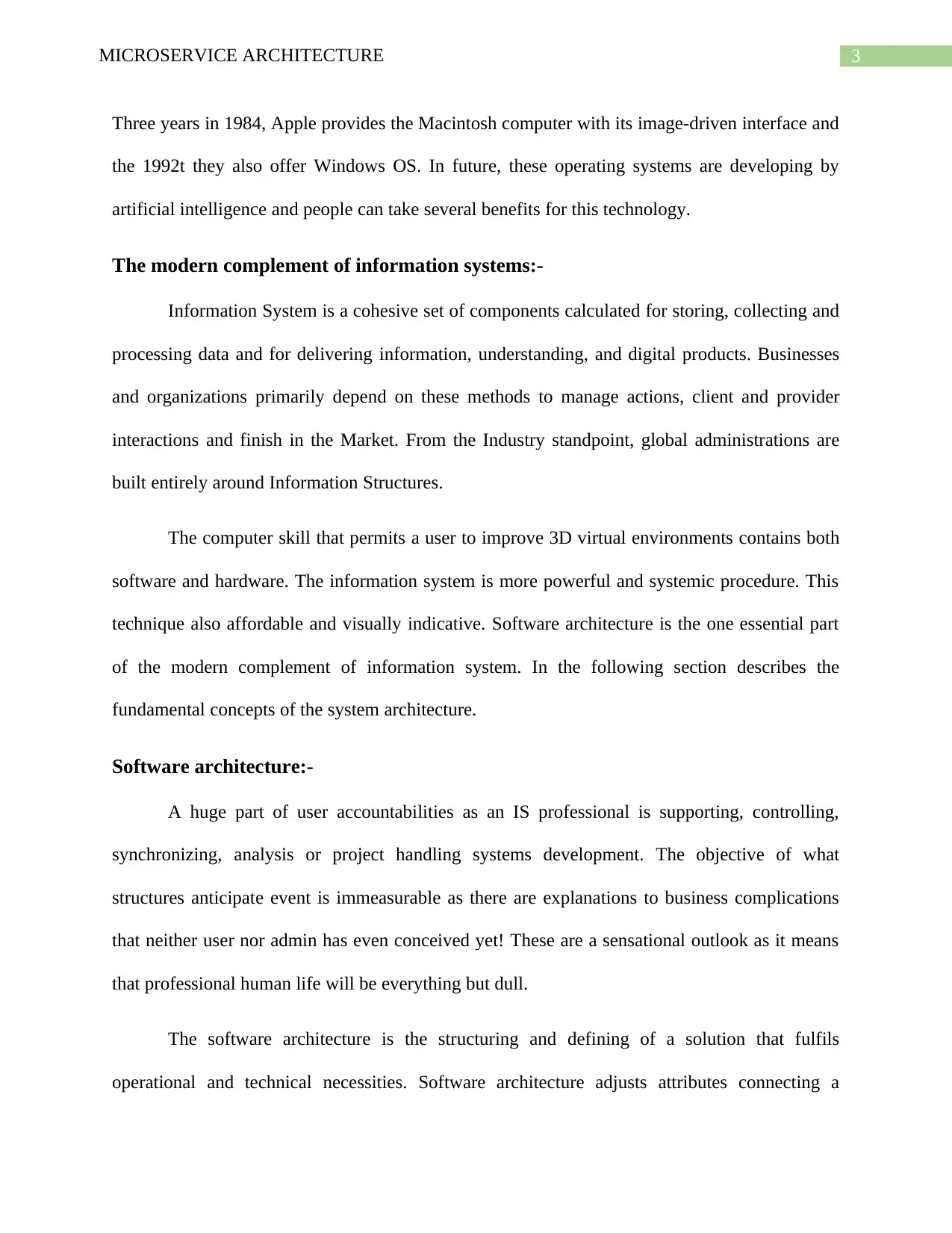
3MICROSERVICE ARCHITECTURE
Three years in 1984, Apple provides the Macintosh computer with its image-driven interface and
the 1992t they also offer Windows OS. In future, these operating systems are developing by
artificial intelligence and people can take several benefits for this technology.
The modern complement of information systems:-
Information System is a cohesive set of components calculated for storing, collecting and
processing data and for delivering information, understanding, and digital products. Businesses
and organizations primarily depend on these methods to manage actions, client and provider
interactions and finish in the Market. From the Industry standpoint, global administrations are
built entirely around Information Structures.
The computer skill that permits a user to improve 3D virtual environments contains both
software and hardware. The information system is more powerful and systemic procedure. This
technique also affordable and visually indicative. Software architecture is the one essential part
of the modern complement of information system. In the following section describes the
fundamental concepts of the system architecture.
Software architecture:-
A huge part of user accountabilities as an IS professional is supporting, controlling,
synchronizing, analysis or project handling systems development. The objective of what
structures anticipate event is immeasurable as there are explanations to business complications
that neither user nor admin has even conceived yet! These are a sensational outlook as it means
that professional human life will be everything but dull.
The software architecture is the structuring and defining of a solution that fulfils
operational and technical necessities. Software architecture adjusts attributes connecting a
Three years in 1984, Apple provides the Macintosh computer with its image-driven interface and
the 1992t they also offer Windows OS. In future, these operating systems are developing by
artificial intelligence and people can take several benefits for this technology.
The modern complement of information systems:-
Information System is a cohesive set of components calculated for storing, collecting and
processing data and for delivering information, understanding, and digital products. Businesses
and organizations primarily depend on these methods to manage actions, client and provider
interactions and finish in the Market. From the Industry standpoint, global administrations are
built entirely around Information Structures.
The computer skill that permits a user to improve 3D virtual environments contains both
software and hardware. The information system is more powerful and systemic procedure. This
technique also affordable and visually indicative. Software architecture is the one essential part
of the modern complement of information system. In the following section describes the
fundamental concepts of the system architecture.
Software architecture:-
A huge part of user accountabilities as an IS professional is supporting, controlling,
synchronizing, analysis or project handling systems development. The objective of what
structures anticipate event is immeasurable as there are explanations to business complications
that neither user nor admin has even conceived yet! These are a sensational outlook as it means
that professional human life will be everything but dull.
The software architecture is the structuring and defining of a solution that fulfils
operational and technical necessities. Software architecture adjusts attributes connecting a
Secure Best Marks with AI Grader
Need help grading? Try our AI Grader for instant feedback on your assignments.
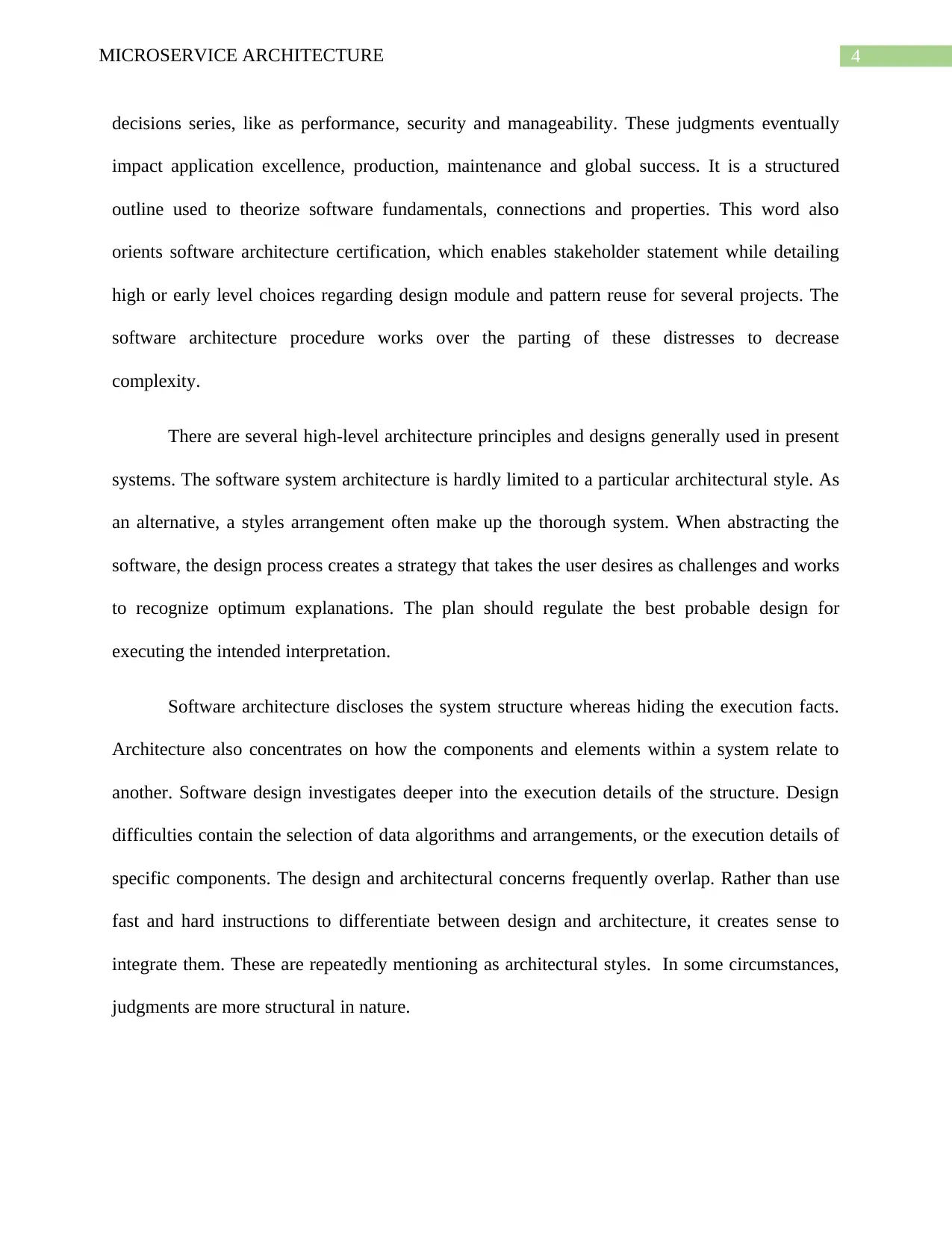
4MICROSERVICE ARCHITECTURE
decisions series, like as performance, security and manageability. These judgments eventually
impact application excellence, production, maintenance and global success. It is a structured
outline used to theorize software fundamentals, connections and properties. This word also
orients software architecture certification, which enables stakeholder statement while detailing
high or early level choices regarding design module and pattern reuse for several projects. The
software architecture procedure works over the parting of these distresses to decrease
complexity.
There are several high-level architecture principles and designs generally used in present
systems. The software system architecture is hardly limited to a particular architectural style. As
an alternative, a styles arrangement often make up the thorough system. When abstracting the
software, the design process creates a strategy that takes the user desires as challenges and works
to recognize optimum explanations. The plan should regulate the best probable design for
executing the intended interpretation.
Software architecture discloses the system structure whereas hiding the execution facts.
Architecture also concentrates on how the components and elements within a system relate to
another. Software design investigates deeper into the execution details of the structure. Design
difficulties contain the selection of data algorithms and arrangements, or the execution details of
specific components. The design and architectural concerns frequently overlap. Rather than use
fast and hard instructions to differentiate between design and architecture, it creates sense to
integrate them. These are repeatedly mentioning as architectural styles. In some circumstances,
judgments are more structural in nature.
decisions series, like as performance, security and manageability. These judgments eventually
impact application excellence, production, maintenance and global success. It is a structured
outline used to theorize software fundamentals, connections and properties. This word also
orients software architecture certification, which enables stakeholder statement while detailing
high or early level choices regarding design module and pattern reuse for several projects. The
software architecture procedure works over the parting of these distresses to decrease
complexity.
There are several high-level architecture principles and designs generally used in present
systems. The software system architecture is hardly limited to a particular architectural style. As
an alternative, a styles arrangement often make up the thorough system. When abstracting the
software, the design process creates a strategy that takes the user desires as challenges and works
to recognize optimum explanations. The plan should regulate the best probable design for
executing the intended interpretation.
Software architecture discloses the system structure whereas hiding the execution facts.
Architecture also concentrates on how the components and elements within a system relate to
another. Software design investigates deeper into the execution details of the structure. Design
difficulties contain the selection of data algorithms and arrangements, or the execution details of
specific components. The design and architectural concerns frequently overlap. Rather than use
fast and hard instructions to differentiate between design and architecture, it creates sense to
integrate them. These are repeatedly mentioning as architectural styles. In some circumstances,
judgments are more structural in nature.
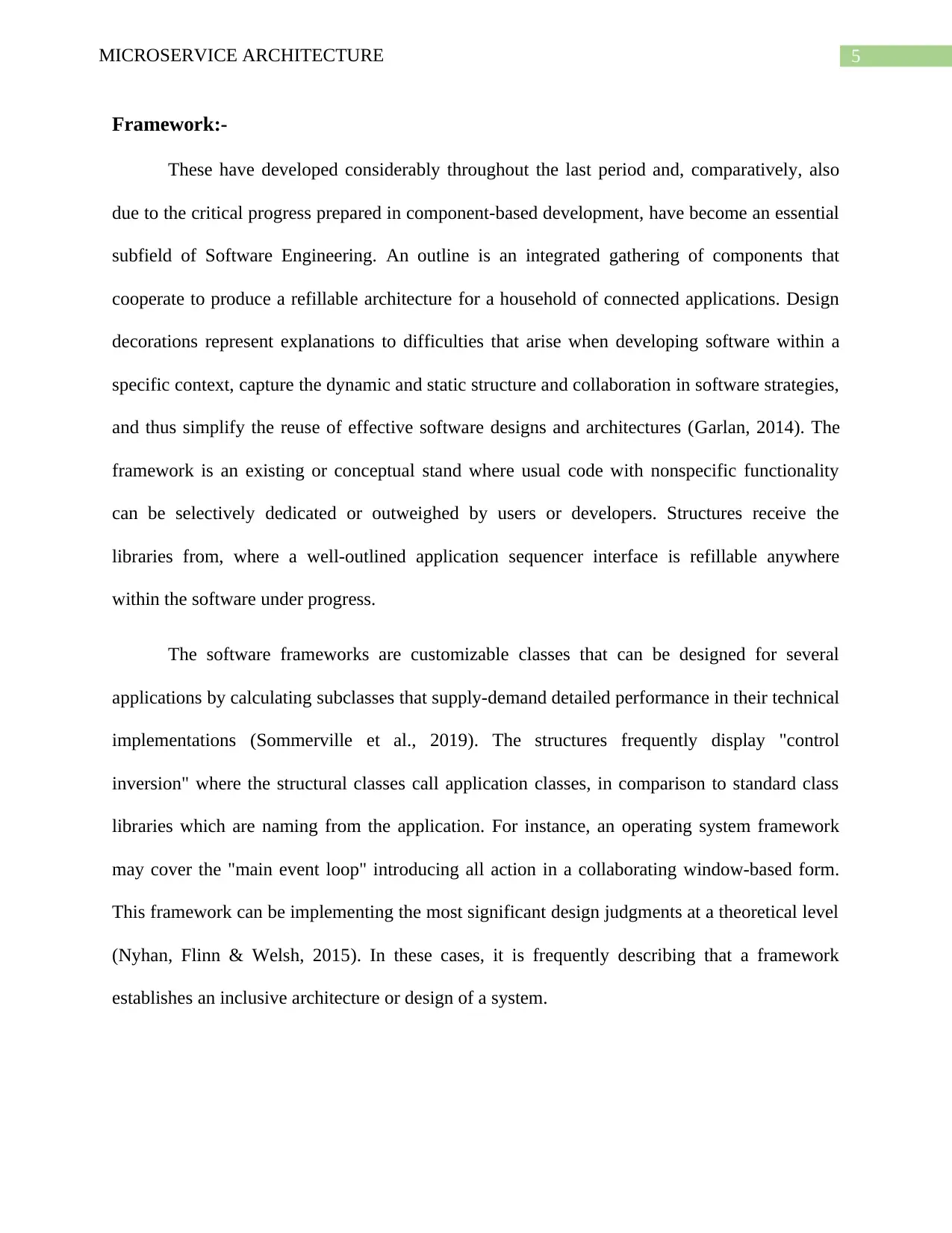
5MICROSERVICE ARCHITECTURE
Framework:-
These have developed considerably throughout the last period and, comparatively, also
due to the critical progress prepared in component-based development, have become an essential
subfield of Software Engineering. An outline is an integrated gathering of components that
cooperate to produce a refillable architecture for a household of connected applications. Design
decorations represent explanations to difficulties that arise when developing software within a
specific context, capture the dynamic and static structure and collaboration in software strategies,
and thus simplify the reuse of effective software designs and architectures (Garlan, 2014). The
framework is an existing or conceptual stand where usual code with nonspecific functionality
can be selectively dedicated or outweighed by users or developers. Structures receive the
libraries from, where a well-outlined application sequencer interface is refillable anywhere
within the software under progress.
The software frameworks are customizable classes that can be designed for several
applications by calculating subclasses that supply-demand detailed performance in their technical
implementations (Sommerville et al., 2019). The structures frequently display "control
inversion" where the structural classes call application classes, in comparison to standard class
libraries which are naming from the application. For instance, an operating system framework
may cover the "main event loop" introducing all action in a collaborating window-based form.
This framework can be implementing the most significant design judgments at a theoretical level
(Nyhan, Flinn & Welsh, 2015). In these cases, it is frequently describing that a framework
establishes an inclusive architecture or design of a system.
Framework:-
These have developed considerably throughout the last period and, comparatively, also
due to the critical progress prepared in component-based development, have become an essential
subfield of Software Engineering. An outline is an integrated gathering of components that
cooperate to produce a refillable architecture for a household of connected applications. Design
decorations represent explanations to difficulties that arise when developing software within a
specific context, capture the dynamic and static structure and collaboration in software strategies,
and thus simplify the reuse of effective software designs and architectures (Garlan, 2014). The
framework is an existing or conceptual stand where usual code with nonspecific functionality
can be selectively dedicated or outweighed by users or developers. Structures receive the
libraries from, where a well-outlined application sequencer interface is refillable anywhere
within the software under progress.
The software frameworks are customizable classes that can be designed for several
applications by calculating subclasses that supply-demand detailed performance in their technical
implementations (Sommerville et al., 2019). The structures frequently display "control
inversion" where the structural classes call application classes, in comparison to standard class
libraries which are naming from the application. For instance, an operating system framework
may cover the "main event loop" introducing all action in a collaborating window-based form.
This framework can be implementing the most significant design judgments at a theoretical level
(Nyhan, Flinn & Welsh, 2015). In these cases, it is frequently describing that a framework
establishes an inclusive architecture or design of a system.
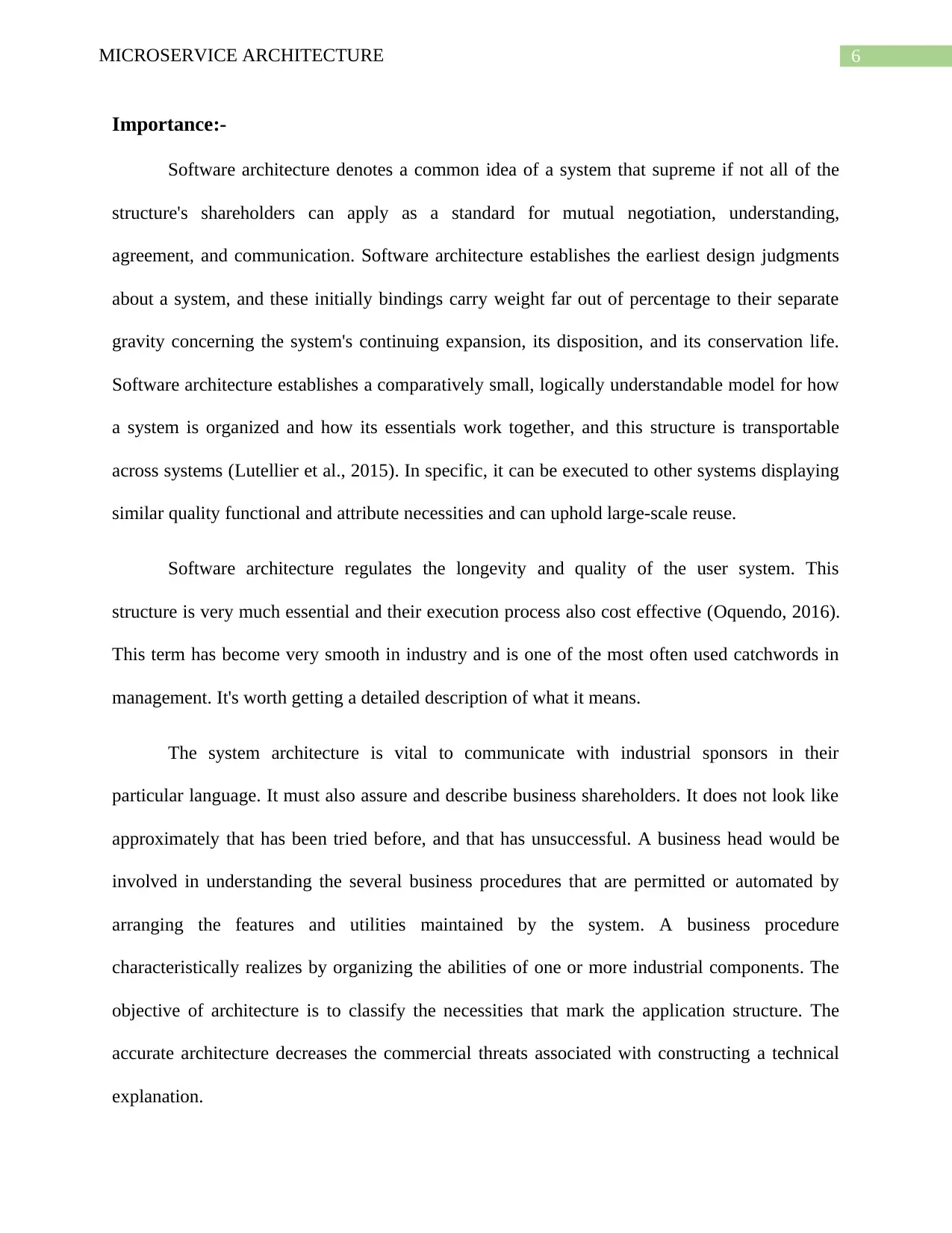
6MICROSERVICE ARCHITECTURE
Importance:-
Software architecture denotes a common idea of a system that supreme if not all of the
structure's shareholders can apply as a standard for mutual negotiation, understanding,
agreement, and communication. Software architecture establishes the earliest design judgments
about a system, and these initially bindings carry weight far out of percentage to their separate
gravity concerning the system's continuing expansion, its disposition, and its conservation life.
Software architecture establishes a comparatively small, logically understandable model for how
a system is organized and how its essentials work together, and this structure is transportable
across systems (Lutellier et al., 2015). In specific, it can be executed to other systems displaying
similar quality functional and attribute necessities and can uphold large-scale reuse.
Software architecture regulates the longevity and quality of the user system. This
structure is very much essential and their execution process also cost effective (Oquendo, 2016).
This term has become very smooth in industry and is one of the most often used catchwords in
management. It's worth getting a detailed description of what it means.
The system architecture is vital to communicate with industrial sponsors in their
particular language. It must also assure and describe business shareholders. It does not look like
approximately that has been tried before, and that has unsuccessful. A business head would be
involved in understanding the several business procedures that are permitted or automated by
arranging the features and utilities maintained by the system. A business procedure
characteristically realizes by organizing the abilities of one or more industrial components. The
objective of architecture is to classify the necessities that mark the application structure. The
accurate architecture decreases the commercial threats associated with constructing a technical
explanation.
Importance:-
Software architecture denotes a common idea of a system that supreme if not all of the
structure's shareholders can apply as a standard for mutual negotiation, understanding,
agreement, and communication. Software architecture establishes the earliest design judgments
about a system, and these initially bindings carry weight far out of percentage to their separate
gravity concerning the system's continuing expansion, its disposition, and its conservation life.
Software architecture establishes a comparatively small, logically understandable model for how
a system is organized and how its essentials work together, and this structure is transportable
across systems (Lutellier et al., 2015). In specific, it can be executed to other systems displaying
similar quality functional and attribute necessities and can uphold large-scale reuse.
Software architecture regulates the longevity and quality of the user system. This
structure is very much essential and their execution process also cost effective (Oquendo, 2016).
This term has become very smooth in industry and is one of the most often used catchwords in
management. It's worth getting a detailed description of what it means.
The system architecture is vital to communicate with industrial sponsors in their
particular language. It must also assure and describe business shareholders. It does not look like
approximately that has been tried before, and that has unsuccessful. A business head would be
involved in understanding the several business procedures that are permitted or automated by
arranging the features and utilities maintained by the system. A business procedure
characteristically realizes by organizing the abilities of one or more industrial components. The
objective of architecture is to classify the necessities that mark the application structure. The
accurate architecture decreases the commercial threats associated with constructing a technical
explanation.
Paraphrase This Document
Need a fresh take? Get an instant paraphrase of this document with our AI Paraphraser
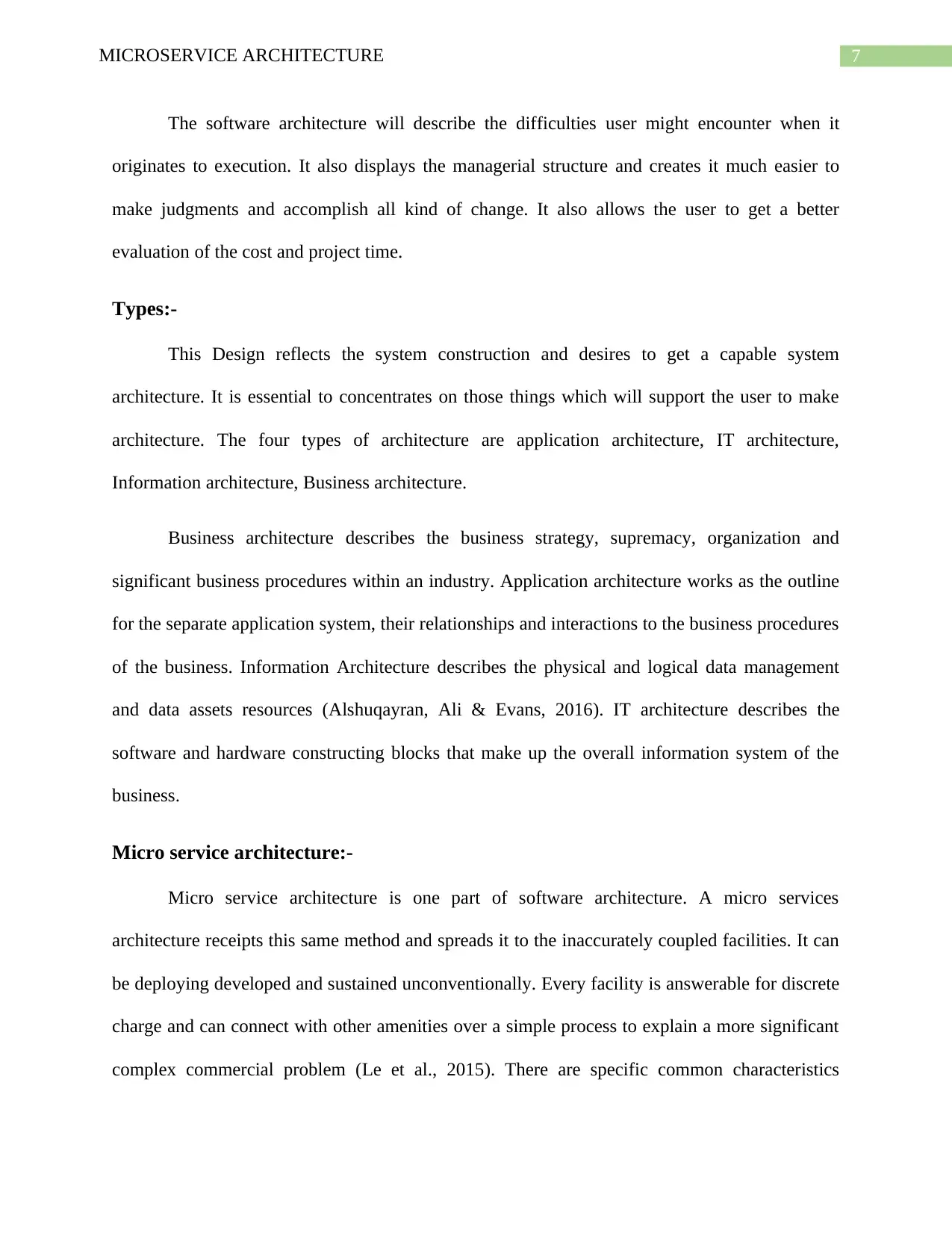
7MICROSERVICE ARCHITECTURE
The software architecture will describe the difficulties user might encounter when it
originates to execution. It also displays the managerial structure and creates it much easier to
make judgments and accomplish all kind of change. It also allows the user to get a better
evaluation of the cost and project time.
Types:-
This Design reflects the system construction and desires to get a capable system
architecture. It is essential to concentrates on those things which will support the user to make
architecture. The four types of architecture are application architecture, IT architecture,
Information architecture, Business architecture.
Business architecture describes the business strategy, supremacy, organization and
significant business procedures within an industry. Application architecture works as the outline
for the separate application system, their relationships and interactions to the business procedures
of the business. Information Architecture describes the physical and logical data management
and data assets resources (Alshuqayran, Ali & Evans, 2016). IT architecture describes the
software and hardware constructing blocks that make up the overall information system of the
business.
Micro service architecture:-
Micro service architecture is one part of software architecture. A micro services
architecture receipts this same method and spreads it to the inaccurately coupled facilities. It can
be deploying developed and sustained unconventionally. Every facility is answerable for discrete
charge and can connect with other amenities over a simple process to explain a more significant
complex commercial problem (Le et al., 2015). There are specific common characteristics
The software architecture will describe the difficulties user might encounter when it
originates to execution. It also displays the managerial structure and creates it much easier to
make judgments and accomplish all kind of change. It also allows the user to get a better
evaluation of the cost and project time.
Types:-
This Design reflects the system construction and desires to get a capable system
architecture. It is essential to concentrates on those things which will support the user to make
architecture. The four types of architecture are application architecture, IT architecture,
Information architecture, Business architecture.
Business architecture describes the business strategy, supremacy, organization and
significant business procedures within an industry. Application architecture works as the outline
for the separate application system, their relationships and interactions to the business procedures
of the business. Information Architecture describes the physical and logical data management
and data assets resources (Alshuqayran, Ali & Evans, 2016). IT architecture describes the
software and hardware constructing blocks that make up the overall information system of the
business.
Micro service architecture:-
Micro service architecture is one part of software architecture. A micro services
architecture receipts this same method and spreads it to the inaccurately coupled facilities. It can
be deploying developed and sustained unconventionally. Every facility is answerable for discrete
charge and can connect with other amenities over a simple process to explain a more significant
complex commercial problem (Le et al., 2015). There are specific common characteristics
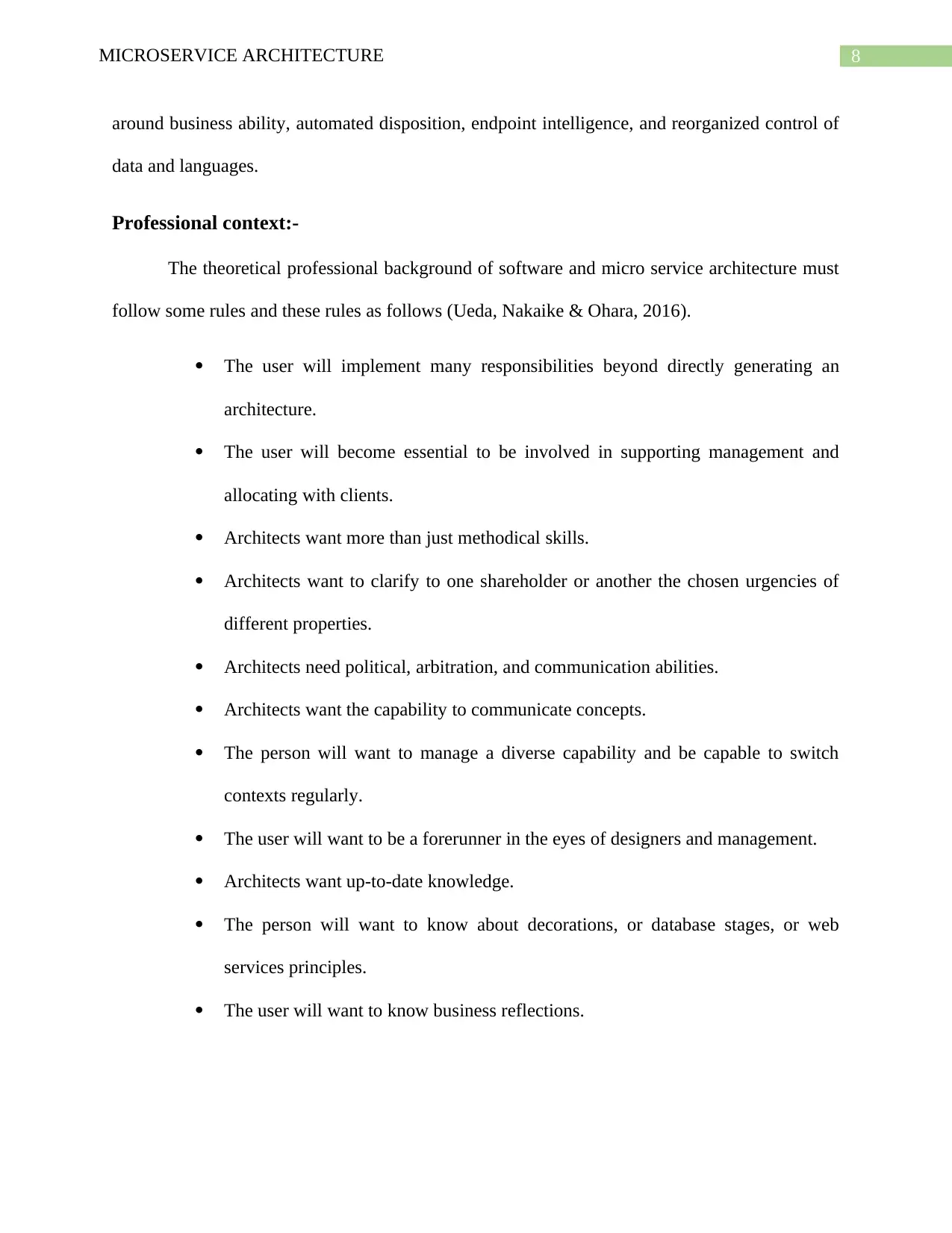
8MICROSERVICE ARCHITECTURE
around business ability, automated disposition, endpoint intelligence, and reorganized control of
data and languages.
Professional context:-
The theoretical professional background of software and micro service architecture must
follow some rules and these rules as follows (Ueda, Nakaike & Ohara, 2016).
The user will implement many responsibilities beyond directly generating an
architecture.
The user will become essential to be involved in supporting management and
allocating with clients.
Architects want more than just methodical skills.
Architects want to clarify to one shareholder or another the chosen urgencies of
different properties.
Architects need political, arbitration, and communication abilities.
Architects want the capability to communicate concepts.
The person will want to manage a diverse capability and be capable to switch
contexts regularly.
The user will want to be a forerunner in the eyes of designers and management.
Architects want up-to-date knowledge.
The person will want to know about decorations, or database stages, or web
services principles.
The user will want to know business reflections.
around business ability, automated disposition, endpoint intelligence, and reorganized control of
data and languages.
Professional context:-
The theoretical professional background of software and micro service architecture must
follow some rules and these rules as follows (Ueda, Nakaike & Ohara, 2016).
The user will implement many responsibilities beyond directly generating an
architecture.
The user will become essential to be involved in supporting management and
allocating with clients.
Architects want more than just methodical skills.
Architects want to clarify to one shareholder or another the chosen urgencies of
different properties.
Architects need political, arbitration, and communication abilities.
Architects want the capability to communicate concepts.
The person will want to manage a diverse capability and be capable to switch
contexts regularly.
The user will want to be a forerunner in the eyes of designers and management.
Architects want up-to-date knowledge.
The person will want to know about decorations, or database stages, or web
services principles.
The user will want to know business reflections.
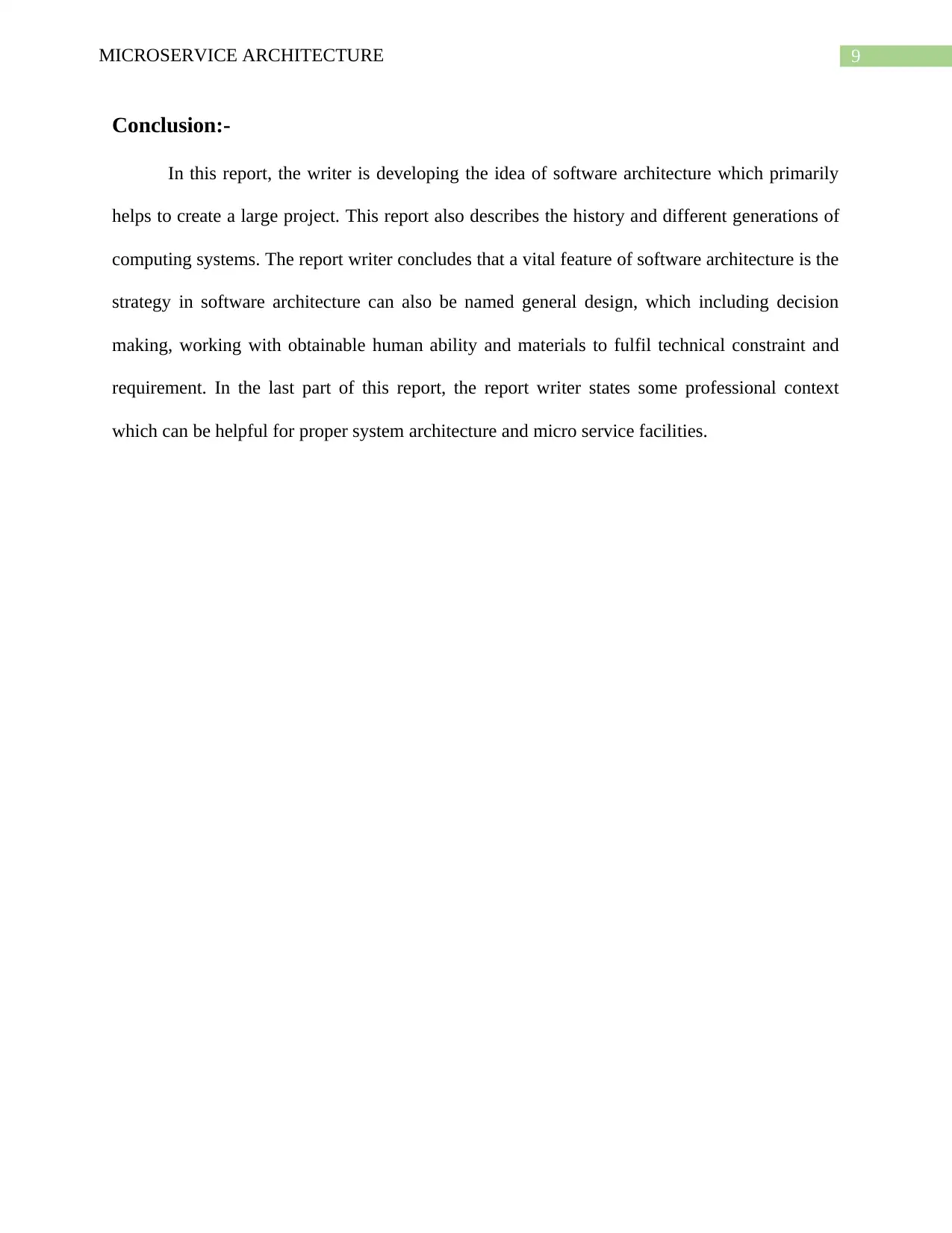
9MICROSERVICE ARCHITECTURE
Conclusion:-
In this report, the writer is developing the idea of software architecture which primarily
helps to create a large project. This report also describes the history and different generations of
computing systems. The report writer concludes that a vital feature of software architecture is the
strategy in software architecture can also be named general design, which including decision
making, working with obtainable human ability and materials to fulfil technical constraint and
requirement. In the last part of this report, the report writer states some professional context
which can be helpful for proper system architecture and micro service facilities.
Conclusion:-
In this report, the writer is developing the idea of software architecture which primarily
helps to create a large project. This report also describes the history and different generations of
computing systems. The report writer concludes that a vital feature of software architecture is the
strategy in software architecture can also be named general design, which including decision
making, working with obtainable human ability and materials to fulfil technical constraint and
requirement. In the last part of this report, the report writer states some professional context
which can be helpful for proper system architecture and micro service facilities.
Secure Best Marks with AI Grader
Need help grading? Try our AI Grader for instant feedback on your assignments.
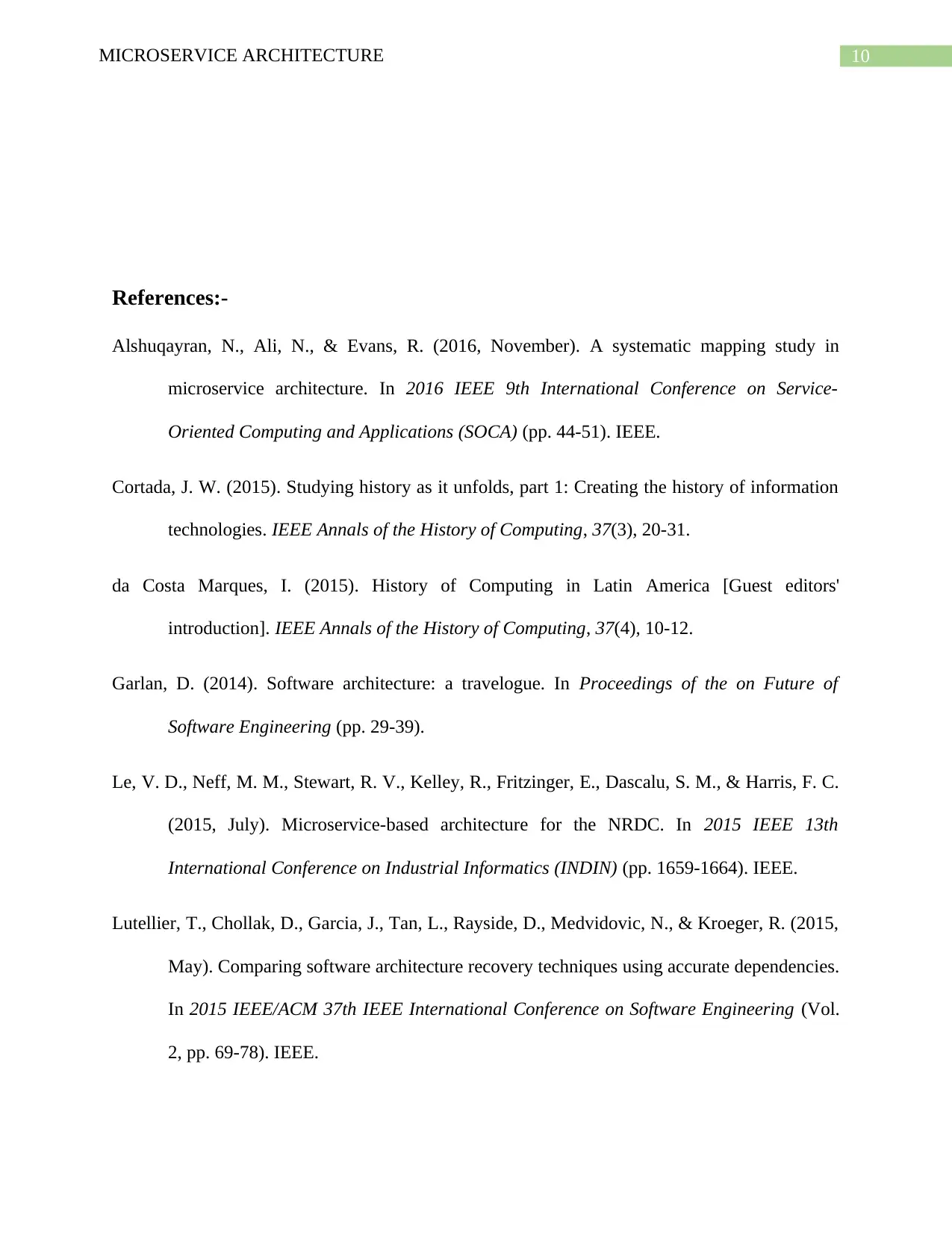
10MICROSERVICE ARCHITECTURE
References:-
Alshuqayran, N., Ali, N., & Evans, R. (2016, November). A systematic mapping study in
microservice architecture. In 2016 IEEE 9th International Conference on Service-
Oriented Computing and Applications (SOCA) (pp. 44-51). IEEE.
Cortada, J. W. (2015). Studying history as it unfolds, part 1: Creating the history of information
technologies. IEEE Annals of the History of Computing, 37(3), 20-31.
da Costa Marques, I. (2015). History of Computing in Latin America [Guest editors'
introduction]. IEEE Annals of the History of Computing, 37(4), 10-12.
Garlan, D. (2014). Software architecture: a travelogue. In Proceedings of the on Future of
Software Engineering (pp. 29-39).
Le, V. D., Neff, M. M., Stewart, R. V., Kelley, R., Fritzinger, E., Dascalu, S. M., & Harris, F. C.
(2015, July). Microservice-based architecture for the NRDC. In 2015 IEEE 13th
International Conference on Industrial Informatics (INDIN) (pp. 1659-1664). IEEE.
Lutellier, T., Chollak, D., Garcia, J., Tan, L., Rayside, D., Medvidovic, N., & Kroeger, R. (2015,
May). Comparing software architecture recovery techniques using accurate dependencies.
In 2015 IEEE/ACM 37th IEEE International Conference on Software Engineering (Vol.
2, pp. 69-78). IEEE.
References:-
Alshuqayran, N., Ali, N., & Evans, R. (2016, November). A systematic mapping study in
microservice architecture. In 2016 IEEE 9th International Conference on Service-
Oriented Computing and Applications (SOCA) (pp. 44-51). IEEE.
Cortada, J. W. (2015). Studying history as it unfolds, part 1: Creating the history of information
technologies. IEEE Annals of the History of Computing, 37(3), 20-31.
da Costa Marques, I. (2015). History of Computing in Latin America [Guest editors'
introduction]. IEEE Annals of the History of Computing, 37(4), 10-12.
Garlan, D. (2014). Software architecture: a travelogue. In Proceedings of the on Future of
Software Engineering (pp. 29-39).
Le, V. D., Neff, M. M., Stewart, R. V., Kelley, R., Fritzinger, E., Dascalu, S. M., & Harris, F. C.
(2015, July). Microservice-based architecture for the NRDC. In 2015 IEEE 13th
International Conference on Industrial Informatics (INDIN) (pp. 1659-1664). IEEE.
Lutellier, T., Chollak, D., Garcia, J., Tan, L., Rayside, D., Medvidovic, N., & Kroeger, R. (2015,
May). Comparing software architecture recovery techniques using accurate dependencies.
In 2015 IEEE/ACM 37th IEEE International Conference on Software Engineering (Vol.
2, pp. 69-78). IEEE.
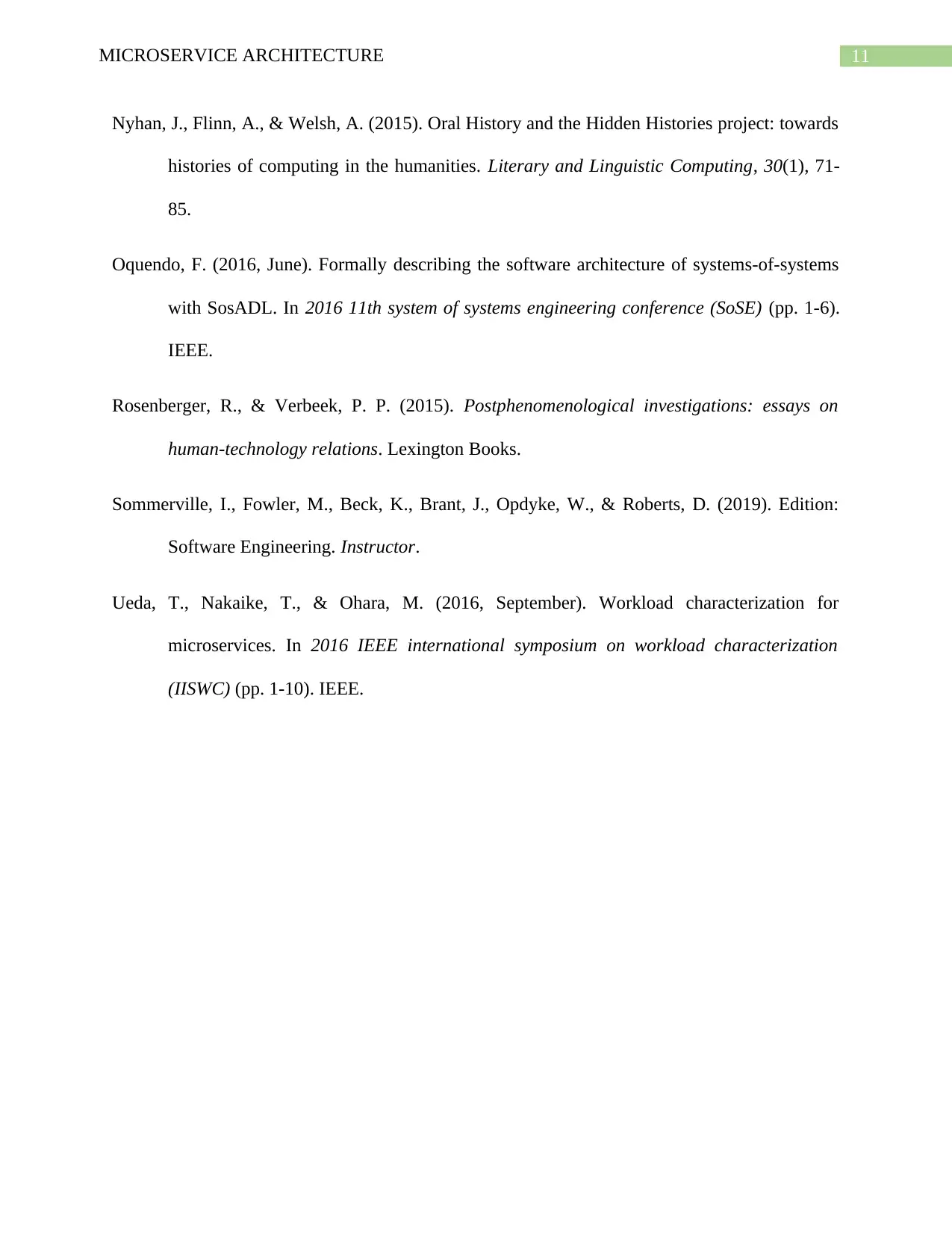
11MICROSERVICE ARCHITECTURE
Nyhan, J., Flinn, A., & Welsh, A. (2015). Oral History and the Hidden Histories project: towards
histories of computing in the humanities. Literary and Linguistic Computing, 30(1), 71-
85.
Oquendo, F. (2016, June). Formally describing the software architecture of systems-of-systems
with SosADL. In 2016 11th system of systems engineering conference (SoSE) (pp. 1-6).
IEEE.
Rosenberger, R., & Verbeek, P. P. (2015). Postphenomenological investigations: essays on
human-technology relations. Lexington Books.
Sommerville, I., Fowler, M., Beck, K., Brant, J., Opdyke, W., & Roberts, D. (2019). Edition:
Software Engineering. Instructor.
Ueda, T., Nakaike, T., & Ohara, M. (2016, September). Workload characterization for
microservices. In 2016 IEEE international symposium on workload characterization
(IISWC) (pp. 1-10). IEEE.
Nyhan, J., Flinn, A., & Welsh, A. (2015). Oral History and the Hidden Histories project: towards
histories of computing in the humanities. Literary and Linguistic Computing, 30(1), 71-
85.
Oquendo, F. (2016, June). Formally describing the software architecture of systems-of-systems
with SosADL. In 2016 11th system of systems engineering conference (SoSE) (pp. 1-6).
IEEE.
Rosenberger, R., & Verbeek, P. P. (2015). Postphenomenological investigations: essays on
human-technology relations. Lexington Books.
Sommerville, I., Fowler, M., Beck, K., Brant, J., Opdyke, W., & Roberts, D. (2019). Edition:
Software Engineering. Instructor.
Ueda, T., Nakaike, T., & Ohara, M. (2016, September). Workload characterization for
microservices. In 2016 IEEE international symposium on workload characterization
(IISWC) (pp. 1-10). IEEE.
1 out of 12
Your All-in-One AI-Powered Toolkit for Academic Success.
+13062052269
info@desklib.com
Available 24*7 on WhatsApp / Email
![[object Object]](/_next/static/media/star-bottom.7253800d.svg)
Unlock your academic potential
© 2024 | Zucol Services PVT LTD | All rights reserved.

